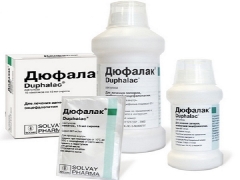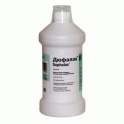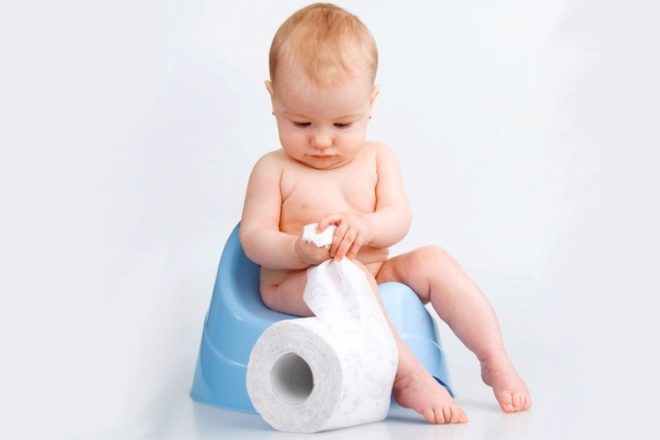Duphalac for children: instructions for use
Many mothers are faced with constipation in a child, but they are afraid of giving laxative medicines, and for good reason. Doctors should prescribe such products to babies, if there are really good reasons for taking them. One of the drugs in this group is Duphalac. Is it possible to give it to young children, how does such a drug affect the child’s body and in what dosage is it used?
Release form
Duphalac is produced in the form of a syrup, which is a viscous sweet transparent liquid. It can either be colorless or have a light yellow or brown tint. The drug is sold in white plastic bottles with a capacity of 200 and 500 ml. There are also large packs of 1000 ml of syrup and packs with 10 portion sachets, each containing 15 ml of medication. On the bottles there is a polypropylene cap on top that serves as a measuring cup.
Composition
The active component of Duphalac is lactulose. In 100 ml of the drug contains 66.7 g (667 mg per 1 ml), and the remaining amount is represented by purified water. There are no other ingredients in the syrup.
Operating principle
The laxative effect of taking Duphalac is associated with the hyperosmotic effect of lactulose. This ingredient is broken down in the colon by normal microflora with the formation of low molecular weight organic acids. This reduces the pH and increases the osmotic pressure in the intestinal lumen. In addition, under the action of the syrup, the absorption of calcium and phosphate salts is improved, and ammonium ions are more actively eliminated. As a result, the stool consistency changes, the intestinal contents increase, and the peristalsis is activated.
Taking the medication not only helps to restore the natural (physiological) rhythm of emptying, but also has a beneficial effect on the state of the microflora, due to which lactulose is classified as a prebiotic substance. This substance stimulates the growth of lacto-and bifidobacteria, which inhibits pathogenic microorganisms, for example, E. coli and clostridia.
Duphalac is almost not absorbed in the gastrointestinal tract. After ingestion, the drug moves through the digestive system to the colon without any changes. At a dosage of less than 75 ml, the medicament is completely broken down by the intestinal microflora. If you drink more syrup, then the excess is displayed unchanged with feces.
Indications
Most often, Duphalac is prescribed for constipation if the physiological rhythm of defecation is disturbed for one reason or another. In addition, the drug is used to soften the feces, which may be necessary for hemorrhoids or in the postoperative period. Adults syrup is also prescribed for hepatic encephalopathy.
At what age is it allowed to take?
Age restrictions in taking Dufalak are not indicated in the syrup instructions by the manufacturer. This tool can be given even to newborns, but only after examination by a doctor. It does not harm pregnant women or breastfeeding. However, it is not recommended to give this medicine to either a 3-month or 7-month or one-year-old or older children without the consent of a pediatrician.
The drug in sachets is usually prescribed to children over 7 years old, since the contents should be taken immediately, and the syrup contained in one package is one dose only for young patients of this age group. But, if a single dose of less than 15 ml is determined by a doctor at the age of 7 years and older, the medicine should be used in a bottle.
And now we will listen to Dr. Komarovsky about how to treat constipation in children.
Contraindications
The drug should not be taken:
- In case of hypersensitivity to lactulose;
- With intestinal obstruction;
- When galactosemia;
- Perforation of the walls of the gastrointestinal tract;
- When fructose intolerance;
- With a shortage of lactase;
- When glucose-galactose malabsorption;
- With intolerance to galactose.
If a child has diabetes, medication is prescribed with caution.
Side effects
Many patients in the first days of Duphalac administration develop flatulence, which soon passes. Other possible adverse reactions to the drug are abdominal pain, diarrhea, bouts of vomiting, nausea. You can get rid of them by reducing the dose or stopping treatment. If the medication provoked severe diarrhea, it can lead to an imbalance of electrolytes and water.
Instructions for use
- The drug is taken orally, both undiluted and diluted with water, milk, milk mixture.
- Babies medicine is given with a spoon or with a syringe without a needle.
- Duphalac is usually prescribed by the doctor in a daily dose. It can be taken all at once once a day or divided into 2 doses.
- After observing the response to treatment, the doctor may adjust the initial dose in a few days.
- Syrup in the right quantity should be swallowed immediately, without delaying the medication in the oral cavity.
- If the drug is prescribed daily 1 time per day, Dufalac is advised to take at the same time.
- It is important to ensure that the child drank enough liquid during treatment.
- For accurate determination of the dose to the bottle of medicine attached measuring cup.
- If the medicine is in sachets, then, tearing off a corner of the package, the contents are poured into the mouth and immediately swallowed.
- The doctor determines for each child individually the duration of Duphalac administration. Since the tool is not able to accumulate in the human body, it can be given as long as necessary to normalize the work of the digestive tract.
- If the medicine is used as a prebiotic, the minimum duration of the course is 1 month.
Dosage
The daily dose of the drug is determined by the age of the small patient.
- A child up to a year. The doctor determines the initial dose individually, but it does not exceed 5 ml. For maintenance treatment, the amount of the drug per day is also not more than 5 ml.
- A child aged 1 to 6 years. Per day give from 5 to 10 ml of syrup. For dosing using measuring cup.
- A child of 7-14 years. Treatment begins with 15 ml of medication per day (you can take 1 portion bag), and maintenance therapy requires 10 to 15 ml per day.
- Teenager over 14 years old. The initial dose can be from 15 to 45 ml (up to 3 bags), and after assessing tolerability, the daily dosage is reduced to 15-30 ml (give 1 or 2 portion bags per day).
Overdose
A very large dose of Duphalac causes diarrhea and pain in the abdomen. If a child loses a lot of liquid stool during an overdose, dehydration may begin, which requires the use of rehydration solutions.
And now to your attention an interesting story about the drug Duphalac
Interaction with other drugs
The manufacturer does not indicate data on the drug interaction of the syrup with other medicines. However, it is known that lactulose increases the acidity in the colon, which can affect the therapeutic effect of certain drugs, for example, prescribed for colitis.
Terms of sale
To buy any packaging Duphalac in pharmacies, a prescription is not required.On average, the price of a 200 ml bottle is 270-300 rubles. Approximately the same is the package of ten bags of 15 ml.
Storage conditions and shelf life
At home Duphalac should be stored so that the medicine is not accessible to small children. In addition, the storage temperature should not be higher than +25 degrees Celsius. The shelf life of the syrup is 3 years. If it has expired, it is forbidden to give the drug to children.
Reviews
Many mothers speak positively about Dufalac treatment of children, calling such a medicine safe and easy to use, because it is presented with syrup. They note that the drug acts quite gently and practically does not cause any negative side reactions. Drug allergy is very rare.
Syrup is mainly praised for giving children of any age and ease of dosing, but there are also negative reviews, in which there are complaints that the drug does not help, because of which you have to buy another laxative. Also, some mothers Dufalak price seems too high, and the taste - not too pleasant (cloying). In some reviews mention addiction, which arose after a long course of this medication.
Analogs
As a replacement for Duphalacu, you can use other drugs, the main ingredient of which is represented by lactulose, for example:
- Normase. The drug is released in bottles containing 200 ml of syrup.
- Portalak. The package of this syrup contains 250 ml or 500 ml of medicine.
- Romfalak. One bottle of this medication contains 270 g of syrup. This option lactulose is cheaper than the rest.
- Good luck. This drug is sold in bottles of 200 ml, and in 15 ml bags.
In addition, when constipating a child, the doctor may recommend laxatives with a different composition:
- Guttalaks. This sodium picosulphate based drug is broken down in the intestines and stimulates its natural emptying. It is produced in drops, which can be given to children older than two years by prescription of a pediatrician. In addition, there is a tablet form approved for children over 4 years old.
- Forlax. The basis of this drug is macrogol. This tool acts physiologically and is not addictive. The drug is made in pediatric dosage in the form of sachets of powder, from which the solution is prepared. Children are given it at the age of 6 months and older.
- Bisacodyl This medicine is represented by rectal suppositories and coated tablets. It is prescribed to children from the age of 6, although the doctor may prescribe such a drug even earlier (from 2 years of age), if there are indications for this.
- Glitselaks. Such rectal suppositories contain glycerol, which is able to reflex stimulate gastrointestinal motility. Especially for children, the drug is released in a small dosage (0.75 g of glycerin in 1 candle). Such suppositories are allowed to apply from the age of three months.
It is important to note once again that the appointment of any drugs with a laxative effect in children should be controlled by a specialist. Only a pediatrician can determine what is best for a particular small patient. It may be dangerous to give drugs in this group without a doctor's prescription and examination of the child, because each of these medicines has its own contraindications.


































